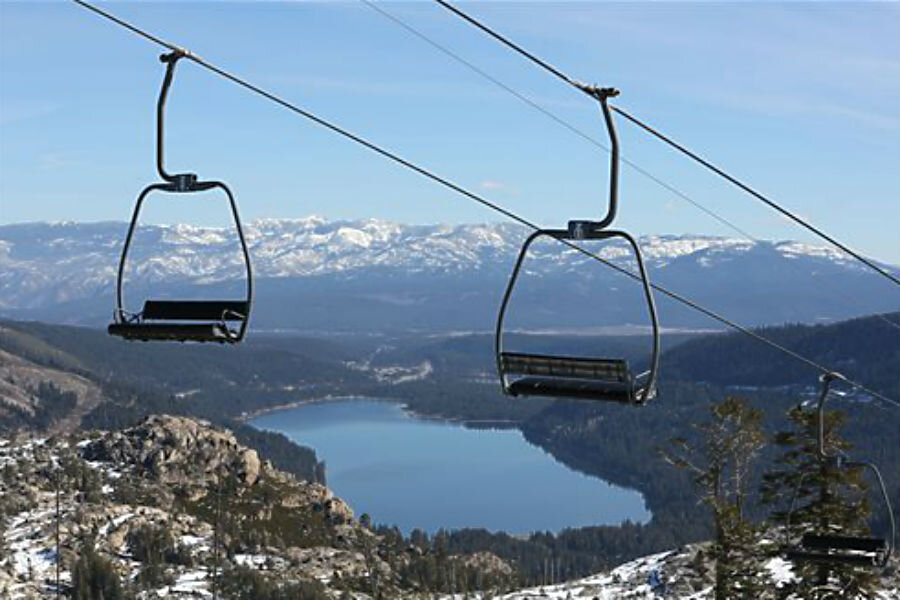Why California's drought means higher utility bills
Loading...
| San Francisco
Flying over the Sierra Nevada as California entered its fourth year of drought, the state's energy chief looked down and saw stark bare granite cloaked in dirty brown haze — not the usual pristine white peaks heaped with snow that would run the state's hydroelectric dams for the year.
Spring is arriving with the Pacific Northwest measuring near record-low-snowfall, and much of the rest of the West below average. But what California is experiencing is historically low snowpack — a meager accumulation that has serious implications not only for the state but potentially for the entire West if the drought not just of water, but of snow, persists.
Snowpack at 12 percent of average in the Sierra Nevada means there is less runoff to feed rivers and streams that run through dams to generate cleanly produced hydroelectric power. Despite the state's ambitious clean-air goals, officials are turning to dirtier, more costly fossil-fuel plants to fill some of the power gap. They also will seek more hydroelectricity imports in a region expected to have markedly less to offer this summer.
At a minimum, "we'll keep the lights on," said Robert Weisenmiller, chairman of the California Energy Commission. "We're not concerned about not having power."
"What we're concerned about," Weisenmiller said, "is the power is going to come from different sources not as benign" for the health of people and the environment as hydroelectricity.
A study this past week by the nonprofit Pacific Institute think tank in Oakland, California, estimated that three years of waning hydroelectricity during California's drought already have cost utility ratepayers $1.4 billion, including purchases of power from natural gas-fired plants to make up for reduced hydroelectric power.
The increased reliance on fossil fuel also caused an 8 percent rise in emissions of climate-changing carbon dioxide in California, the Pacific Institute said.
Robert Oglesby, executive director of the state energy commission, said he didn't expect the decline of hydro power— and the boost in gas-fired power— to set back California's goal of generating 33 percent of electricity from renewable energy by 2020. That's because large hydroelectric dams, which are controversial because they block natural river flows, are not officially included with solar, wind and other sources in California's renewable energy equation.
Dams produced 12 percent of the state's electricity in 2013, the most recent year for which figures are available. Natural gas provided 61 percent.
The numbers for hydroelectric power will go down for California in 2015 but not disappear, Oglesby said. That will mean continued higher utility bills for some.
"For the areas of the state that have been able to rely on inexpensive hydro, and then they have to purchase more expensive energy off the grid — those costs are an impact that will be passed along over time," Oglesby said.
Hydroelectricity is even more important for California's northern neighbors, accounting for more than 60 percent of Washington state's power and 45 percent of Oregon's, state officials say.
While California is 14 months into a statewide drought emergency, the governors of Washington and Oregon, where snowpack is hovering at or near record lows, recently declared drought emergencies in sections of their states.
Strong winter rain will make up for poor snow totals when it comes to hydro power in Washington and Oregon, power managers there said.
"We're not anticipating that we're going to have any problem meeting our obligation," said Michael Hansen, spokesman for the Bonneville Power Administration, which serves utilities in Washington, Oregon, Idaho and western Montana.
"We serve the Northwest first," he said. "They get first dibs on surplus power."
The federal nonprofit agency can sell surplus power to utilities in California and other Western states, but it is required by law to serve its customers first, Hansen said.
Around the West, dam operators will be prioritizing customers, placing water for farms and cities ahead of water for power production.
At Lake Mead on the Colorado River, the largest water reservoir in the United States and a vital water source for the Southwest and Mexico, drought by May is expected to nearly halve hydroelectric production compared with mid-2014 levels.
Keeping drinking water running from Las Vegas to Los Angeles, and crops watered along the way, would take priority over keeping the lights on, officials of the power office of the U.S. Bureau of Reclamation's Lower Colorado division said in an email.
"We always have to point out that as important as power production may be, by law it is actually priority No. 3," the officials said.
___
Associated Press writer Phuong Le in Seattle contributed to this report.
Copyright 2015 The Associated Press. All rights reserved. This material may not be published, broadcast, rewritten or redistributed.





